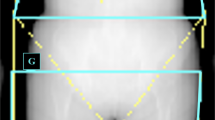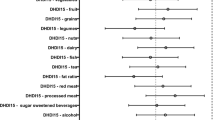Abstract
Objective:
Animal studies have suggested that betaine, but not choline, may improve body composition, but little evidence is available in humans. We examined the association of serum concentrations of choline and betaine with body composition and fat distribution in adults.
Methods:
This community-based study recruited 1996 adults (women/men: 1380/616) aged 40–75 years in urban Guangzhou, China. General information and anthropometric measurements were taken, and serum choline and betaine levels were assessed by high-performance liquid chromatography–tandem mass spectrometry between July 2008 and June 2010. After 3.2 years, 1623 of the 1996 participants were measured for fat mass (FM and %FM) over the total body (TB), trunk, limbs, android (A) and gynoid (G) regions. The %FM ratios of the A/G regions and the trunk and limbs were determined by dual energy X-ray absorptiometry.
Results:
Univariate analyses showed that higher serum betaine levels were significantly associated with lower values of adiposity indices (all P-trends<0.05), except in the case of the %FM at the gynoid area. After adjusting for potential covariates, similar associations were observed. The mean percentage differences between quartiles 4 and 1 of the serum betaine levels were −4.9% (weight), −4.7% (body mass index, BMI), −2.5% (waist circumference), −7.9% (TB FM) and −3.4% (TB %FM). The mean differences in the FM and %FM were much more pronounced at the trunk (−10.0 and −4.5%) or android areas (−10.7 and −4.7%) than those at the limbs (−0.8 and −2.3%) or gynoid areas (−0.6 and −1.4%). Such favorable associations were stronger in men than in women. No significant associations between serum choline and the adiposity indices were observed, except in the cases of body weight and BMI.
Conclusions:
Greater circulating betaine, but not choline, was dose-dependently associated with better body composition and fat distribution due to a lower FM in the trunk regions in this population.
This is a preview of subscription content, access via your institution
Access options
Subscribe to this journal
Receive 12 print issues and online access
$259.00 per year
only $21.58 per issue
Buy this article
- Purchase on Springer Link
- Instant access to full article PDF
Prices may be subject to local taxes which are calculated during checkout


Similar content being viewed by others

References
Zeisel SH, Blusztajn JK . Choline and human nutrition. Annu Rev Nutr 1994; 14: 269–296.
Craig SA . Betaine in human nutrition. Am J Clin Nutr 2004; 80: 539–549.
Ueland PM . Choline and betaine in health and disease. J Inherit Metab Dis 2011; 34: 3–15.
Lever M, Slow S . The clinical significance of betaine, an osmolyte with a key role in methyl group metabolism. Clin Biochem 2010; 43: 732–744.
Konstantinova SV, Tell GS, Vollset SE, Nygard O, Bleie O, Ueland PM . Divergent associations of plasma choline and betaine with components of metabolic syndrome in middle age and elderly men and women. J Nutr 2008; 138: 914–920.
Lever M, George PM, Dellow WJ, Scott RS, Chambers ST . Homocysteine, glycine betaine, and N,N-dimethylglycine in patients attending a lipid clinic. Metabolism 2005; 54: 1–14.
Schwab U, Torronen A, Toppinen L, Alfthan G, Saarinen M, Aro A et al. Betaine supplementation decreases plasma homocysteine concentrations but does not affect body weight, body composition, or resting energy expenditure in human subjects. Am J Clin Nutr 2002; 76: 961–967.
Liu J, Zeng FF, Liu ZM, Zhang CX, Ling WH, Chen YM . Effects of blood triglycerides on cardiovascular and all-cause mortality: a systematic review and meta-analysis of 61 prospective studies. Lipids Health Dis 2013; 12: 159.
Cholewa JM, Wyszczelska-Rokiel M, Glowacki R, Jakubowski H, Matthews T, Wood R et al. Effects of betaine on body composition, performance, and homocysteine thiolactone. J Int Soc Sports Nutr 2013; 10: 39.
Zhang C, Rexrode KM, van Dam RM, Li TY, Hu FB . Abdominal obesity and the risk of all-cause, cardiovascular, and cancer mortality: sixteen years of follow-up in US women. Circulation 2008; 117: 1658–1667.
Staiano AE, Reeder BA, Elliott S, Joffres MR, Pahwa P, Kirkland SA et al. Body mass index versus waist circumference as predictors of mortality in Canadian adults. Int J Obesity 2012; 36: 1450–1454.
Liu YH, Xu Y, Wen YB, Guan K, Ling WH, He LP et al. Association of weight-adjusted body fat and fat distribution with bone mineral density in middle-aged Chinese adults: a cross-sectional study. PLoS One 2013; 8: e63339.
Zhang CX, Ho SC . Validity and reproducibility of a food frequency questionnaire among Chinese women in Guangdong province. Asia Pac J Clin Nutr 2009; 18: 240–250.
Wang P, Chen YM, He LP, Chen CG, Zhang B, Xue WQ et al. Association of natural intake of dietary plant sterols with carotid intima-media thickness and blood lipids in Chinese adults: a cross-section study. PLoS One 2012; 7: e32736.
Ainsworth BE, Haskell WL, Herrmann SD, Meckes N, Bassett DR Jr, Tudor-Locke C et al. Compendium of physical activities: a second update of codes and MET values. Med Sci Sports Exerc 2011; 43: 1575–1581.
Holm PI, Ueland PM, Kvalheim G, Lien EA . Determination of choline, betaine, and dimethylglycine in plasma by a high-throughput method based on normal-phase chromatography-tandem mass spectrometry. Clin Chem 2003; 49: 286–294.
Wang LJ, Zhang HW, Zhou JY, Liu Y, Yang Y, Chen XL et al. Betaine attenuates hepatic steatosis by reducing methylation of the MTTP promoter and elevating genomic methylation in mice fed a high-fat diet. J Nutr Biochem 2014; 25: 329–336.
Cadogan DJ, Campbell RG, Harrison D, Edwards AC . The effects of betaine on the growth performance and carcass characteristics of female pigs. Manipulating Pig Production. Australian Pig Association: Attwood, Victoria, Australia, 1993; p219.
Eklund M, Bauer E, Wamatu J, Mosenthin R . Potential nutritional and physiological functions of betaine in livestock. Nutr Res Rev 2005; 18: 31–48.
Sales J . A meta-analysis of the effects of dietary betaine supplementation on finishing performance and carcass characteristics of pigs. Anim Feed Sci Technol 2011; 165: 68–78.
Wang YZ, Xu ZR, Feng J . The effect of betaine and dl-methionine on growth performance and carcass characteristics in meat ducks. Anim Feed Sci Technol 2004; 116: 151–159.
Zou XT, Lu JJ . Effects of betaine on the regulation of the lipid metabolism in laying hen. Sci Agric Sin 2002; 35: 325–330.
Prospective Studies Collaboration, Whitlock G, Lewington S, Sherliker P, Clarke R, Emberson J et al. Body mass index and cause-specific mortality in 900 000 adults: collaborative analyses of 57 prospective studies. Lancet 2009; 373: 1083–1096.
Lawrence BV, Schinckel AP, Adeola O, Cera K . Impact of betaine on pig finishing performance and carcass composition. J Anim Sci 2002; 80: 475–482.
Huang QC, Xu ZR, Han XY, Li WF . Effect of dietary betaine supplementation on lipogenic enzyme activities and fatty acid synthase mRNA expression in finishing pigs. Anim Feed Sci Technol 2008; 140: 365–375.
Xing J, Kang L, Jiang Y . Effect of dietary betaine supplementation on lipogenesis gene expression and CpG methylation of lipoprotein lipase gene in broilers. Mol Biol Rep 2011; 38: 1975–1981.
Huang QC, Xu ZR, Han XY, Li WF . Changes in hormones, growth factor and lipid metabolism in finishing pigs fed betaine. Livest Sci 2006; 105: 78–85.
Wu G, Zhang L, Li T, Lopaschuk G, Vance DE, Jacobs RL . Choline deficiency attenuates body weight gain and improves glucose tolerance in ob/ob mice. J Obes 2012; 2012: 319172.
Acknowledgements
We are grateful to Yao-zong Tan, Wen-qi Shi, Ya-bin Wen and Li-ping He, and other team staff for their contribution in the data collection and for facilitating both the recruitment of participants and the interviews. This study was jointly supported by the 5010 Program for Clinical Researches by Sun Yat-sen University, Guangzhou, China (No. 2007032) and the National Science Foundation of China (No. 81273050).
Author information
Authors and Affiliations
Corresponding author
Ethics declarations
Competing interests
The authors declare no conflict of interest.
Additional information
Supplementary Information accompanies this paper on International Journal of Obesity website
Supplementary information
Rights and permissions
About this article
Cite this article
Chen, Ym., Liu, Y., Liu, Yh. et al. Higher serum concentrations of betaine rather than choline is associated with better profiles of DXA-derived body fat and fat distribution in Chinese adults. Int J Obes 39, 465–471 (2015). https://doi.org/10.1038/ijo.2014.158
Received:
Revised:
Accepted:
Published:
Issue Date:
DOI: https://doi.org/10.1038/ijo.2014.158
This article is cited by
-
Whole genome sequencing of the halophilic Halomonas qaidamensis XH36, a novel species strain with high ectoine production
Antonie van Leeuwenhoek (2022)
-
Effects of chronic betaine supplementation on performance in professional young soccer players during a competitive season: a double blind, randomized, placebo-controlled trial
Journal of the International Society of Sports Nutrition (2021)
-
Higher erythrocyte n-3 polyunsaturated fatty acid were associated with a better profile of DXA-derived body fat and fat distribution in adults
International Journal of Obesity (2020)
-
Betaine suppresses cell proliferation by increasing oxidative stress–mediated apoptosis and inflammation in DU-145 human prostate cancer cell line
Cell Stress and Chaperones (2019)
-
Safety of TeaCrine®, a non-habituating, naturally-occurring purine alkaloid over eight weeks of continuous use
Journal of the International Society of Sports Nutrition (2016)


